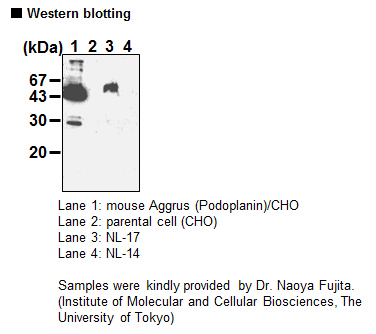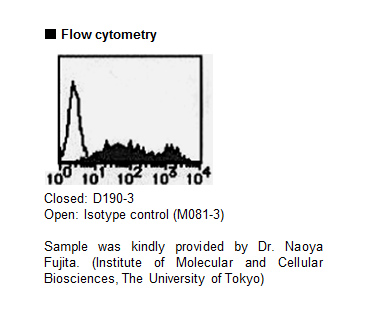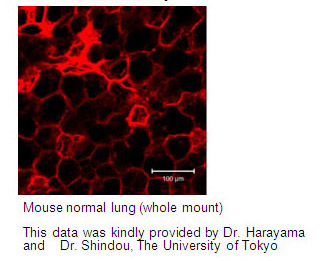This site is for customers in Asia.
Customers in China & other regions, please go to Global page.
HOME >
Product search results > Code No. D190-3
Anti-Aggrus (Podoplanin) (Mouse) mAb
Availability (in Japan)
10 or more
(In Japan at 00:05,
Apr 24, 2024 in JST)
Size
100 µL (1 mg/mL)
| Data | |||||
|---|---|---|---|---|---|
| Clonality | Monoclonal | Clone | 8F11 | ||
| Isotype (Immunized Animal) | Rat IgG2a | ||||
| Applications |
|
||||
| Immunogen (Antigen) | NL-17 cell membrane fraction | ||||
| Reactivity [Gene ID] | Mouse[14726] |
||||
| Storage buffer | 1 mg/mL in PBS/50% glycerol, pH 7.2 | ||||
| Storage temp. | -20°C | Conjugate | Unlabeled | Manufacturer | MBL |
| Alternative names | Pdpn, T1a, Gp38, OTS-8, T1alpha, RANDAM-2, T1-alpha, PA2.26 antigen, glycoprotein 38, transmembrane glycoprotein E11 | ||||
| Background | In addition to hemostasis and host defense, platelets are involved in the induction of inflammation, tissue repair, and tumor metastasis. Aggrus (T1α/Podoplanin) is a novel 36-45 kDa membrane sialoglycoprotein that induces platelet aggregation. Aggrus is highly expressed in various tumor cells and the platelet aggregation ability of Aggrus depends on specific oligosaccharide structures that may be related to the metastasis process in cancer cells. Aggrus has been identified as a diagnostic tumor marker for seminomas and testicular cancers. | ||||
| Related products | D321-A48 Anti-Podoplanin (Mouse) mAb -Alexa Fluor™ 488 D321-3 Anti-Podoplanin (Mouse) mAb |
||||
| Citations |
Western Blotting
Flow Cytometry
Immunocytochemistry
Immunohistochemistry
|
||||
| Product category |
|
||||
- The availability is based on the information in Japan at 00:05, Apr 24, 2024 in JST.
- The special price is shown in red color.
- Please note that products cannot be ordered from this website. To purchase the items listed in this website, please contact us or local distributers.
- Abbreviations for applications:
WB: Western Blotting, IH: Immunohistochemistry, IC: Immunocytochemistry, IP: Immunoprecipitation
FCM: Flow Cytometry, NT: Neutralization, IF: Immunofluorescence, RIP: RNP Immunoprecipitation
ChIP: Chromatin Immunoprecipitation, CoIP: Co-Immunoprecipitation - For applications and reactivity:
*: The use is reported in a research article (Not tested by MBL). Please check the data sheet for detailed information.
**: The use is reported from the licenser (Under evaluation or not tested by MBL).
- For storage temparature: RT: room temparature
- Please note that products in this website might be changed or discontinued without notification in advance for quality improvement.












 Citations
Citations Data Sheet
Data Sheet





